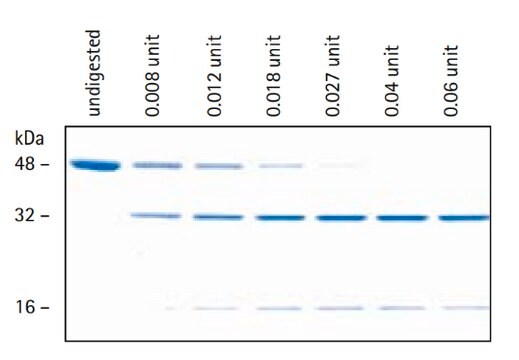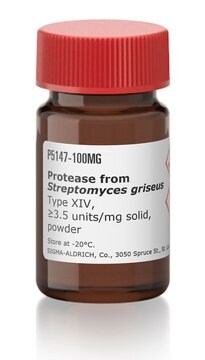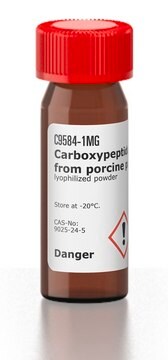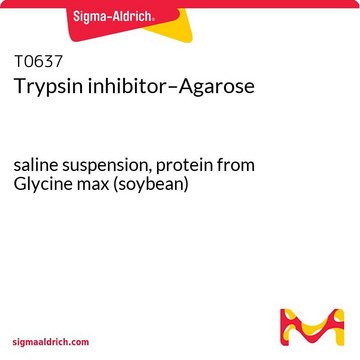E0885
Enterokinase from porcine intestine
lyophilized powder, ≥100 units/mg protein
Synonyme(s) :
Enteropeptidase
Se connecterpour consulter vos tarifs contractuels et ceux de votre entreprise/organisme
About This Item
Produits recommandés
Forme
lyophilized powder
Niveau de qualité
Activité spécifique
≥100 units/mg protein
Poids mol.
150 kDa
Produit purifié par
chromatography
Composition
Protein, ≥20% Lowry
Activité étrangère
aminopeptidase ≤1.5%
trypsin ≤1%, free
Température de stockage
−20°C
Vous recherchez des produits similaires ? Visite Guide de comparaison des produits
Application
Enterokinase from porcine intestine has been used in a study to investigate complementary DNA cloning and sequencing of rat enteropeptidase. Enterokinase from porcine intestine has also been used to learn more about the insulinotropic region of the gastric inhibitory polypeptide.
The enzyme from Sigma has been used to activate zymogens in order to detect trypsin activity. The study to investigated the structural and evolutionary consequences of unpaired cysteines in trypsinogen. The product has been used to measure trypsin while studying the effect of pesticide induced alterations in gene expression in the lobster, Homarus americanus The enzyme from Sigma has been used to develop a novel assay for measuring levels of lipid-free apoA-I in the presence of lipid-bound apoA-I. Enteropeptidase can specifically cleave human lipid-free apoA-I but not its lipid-bound form resulting in an N-terminal fragment of 22 kDa. It has also been used in a study to examine the effect of calcium and phytic acid on the activation of trypsinogen and the stability of trypsin.
Actions biochimiques/physiologiques
Enterokinase is a membrane bound serine protease that specifically and rapidly converts trypsinogen to trypsin, thereby, triggering the conversion of other zymogens to active enzymes. It has a molecular mass of approximately 150 kDa. The enzyme is a heterodimer consisting of 35-47 kDa subunits. The light and the heavy chains are linked by two disulfide bridges. It is a glycoprotein containing 35% carbohydrate. The polypeptide chain of trypsinogen is hydrolyzed only after an -(Asp)4-Lys- sequence. The enzyme is inhibited by soybean trypsin inhibitor. Enterokinase is typically used in protein modification and amino acid sequence determination.
Définition de l'unité
One unit will produce 1.0 nanomole of trypsin from trypsinogen per min at pH 5.6 at 25 °C.
Forme physique
Lyophilized powder containing sodium phosphate buffer salts
Substrat
Réf. du produit
Description
Tarif
Code de la classe de stockage
11 - Combustible Solids
Classe de danger pour l'eau (WGK)
WGK 3
Point d'éclair (°F)
Not applicable
Point d'éclair (°C)
Not applicable
Équipement de protection individuelle
Eyeshields, Gloves, type N95 (US)
Faites votre choix parmi les versions les plus récentes :
Déjà en possession de ce produit ?
Retrouvez la documentation relative aux produits que vous avez récemment achetés dans la Bibliothèque de documents.
W Safi et al.
Journal of lipid research, 42(5), 864-872 (2001-05-16)
Recent studies indicate that certain lipid-poor forms of apolipoprotein (apo)A-I may be particularly important in promoting cholesterol release from overburdened cells in the periphery. However, a detailed understanding of the physiological relevance of these species has been hampered by the
Erzsébet Kénesi et al.
Biochemical and biophysical research communications, 309(4), 749-754 (2003-09-19)
Vertebrate trypsins usually contain six disulfide bonds but human trypsin 1 (PRSS1) contains only five and human trypsin 2 (PRSS2) contains only four. To elucidate possible evolutionary pathways leading to the loss of disulfide bonds, we have constructed mutants lacking
Michael N Horst et al.
Comparative biochemistry and physiology. Part D, Genomics & proteomics, 2(1), 44-52 (2007-03-01)
Using subtractive hybridization, we have identified 17 genes that are either up- or down-regulated in the hepatopancreas (Hp) of the lobster, Homarus americanus, by acute exposure to the juvenile hormone analog methoprene. The expression of some of the genes obtained
Effect of calcium and phytic acid on the activation of trypsinogen and the stability of trypsin.
Caldwell RA
Journal of Agricultural and Food Chemistry, 40 (1), 43-46 (1992)
G W Morrow et al.
Canadian journal of physiology and pharmacology, 74(1), 65-72 (1996-01-01)
Glucose-dependent insulinotropic polypeptide or gastric inhibitory polypeptide (GIP) is a 42 amino acid intestinal hormone, which exhibits several direct and indirect effects on fat and glucose metabolism. To determine the bioactive region(s) of the molecule, synthetic and proteolytic fragments of
Notre équipe de scientifiques dispose d'une expérience dans tous les secteurs de la recherche, notamment en sciences de la vie, science des matériaux, synthèse chimique, chromatographie, analyse et dans de nombreux autres domaines..
Contacter notre Service technique
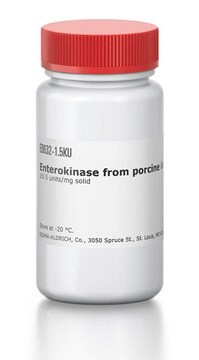

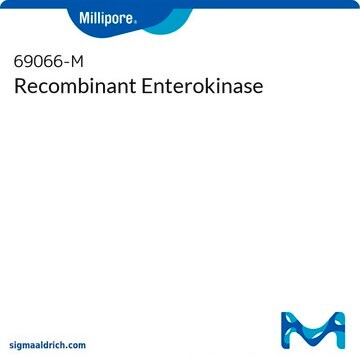
![4-(N-[2,4-Diamino-6-pteridinylmethyl]amino)benzoic acid sodium salt ≥95% (TLC)](/deepweb/assets/sigmaaldrich/product/structures/855/619/06a9574b-3e45-48aa-85c1-2f25917fa5a7/640/06a9574b-3e45-48aa-85c1-2f25917fa5a7.png)
